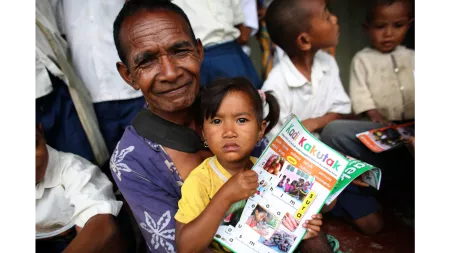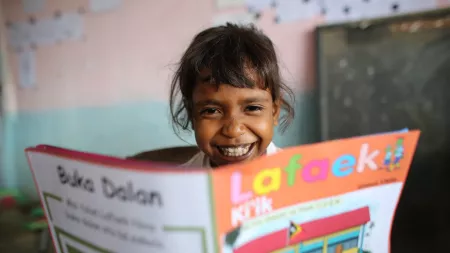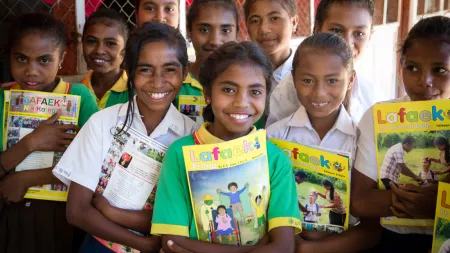What’s the first thing you remember reading? A children’s book? A magazine? A sign in a classroom? In Timor-Leste, for people under the age of 20, the first thing they remember reading is probably something CARE produced. If you have anything in your house to read in rural Timor Leste, it’s going to include Lafaek—a suite of magazines that CARE has been producing since 2001. For 86% of families, it will be the ONLY thing they have to read in the household.
Lafaek is so popular in Timor-Leste that 35% of ALL Facebook users in the country follow the Lafaek page, which has 142,754 followers (approximately 11% of the population of Timor-Leste). It’s the 4th most popular Facebook page in the entire country.
I try to teach [my younger sibling] to learn to read and write, because through the educational vision younger siblings can learn to write and read, because reading a lot [they] can know many thingsAn older sibling on reading Lafaek to assist their younger brothers and sisters
Think of the incredible influence that has—to be the first reading material most children, and many adults, remember. To be the only thing to read at home? It’s no wonder Lafaek has had the incredible influence it has.
Funded primarily by the government of New Zealand, Lafaek has been running since 2001. Between 2007 and 2020, more than 6.5 million copies of the learning magazines were distributed to communities in Timor-Leste.

What changed?
- Children are learning more. Children with access to Lafaek have 5% higher reading scores than those who don’t use it. During COVID, children who used Lafaek had 5% higher learning scores. They can also identify 7 more letters than children without the magazine.
- Adults have higher savings. People who read Lafaek are 13% more likely to have savings than those who don’t.
- People take better precautions against COVID-19. People who read Lafaek were 13% more likely to have a handwashing station. They were likely to know one more COVID-19 prevention strategy and USE one more COVID-19 prevention strategy than those who didn’t read the magazine.
- Mothers are healthier. Women who read the magazine know 2.6 more behaviours to support maternal health than those who don’t.
- Parents are using reading tools, even when schools close. 69% of household heads use Lafaek to help children learn. When COVID-19 restrictions closed schools 68% of people used Lafaek as a way to keep childrean learning. It was the most commonly used tool.
- Children are teaching parents. The games and tools in the magazine are a great way for parents and children to interact. One mother says, “last month, when I was about to make cakes, my child told me “Wait, let me get Lafaek magazine for you, and you can make the cakes based on what is in the magazine like that one.”
- Children teach each other. Older siblings talk about how they use the magazine to work with their brothers and sisters. “My younger sibling is still in the fourth grade, I try to teach [them] to learn to read and write, because through the educational vision younger siblings can learn to write and read, because reading a lot can know many things. I try to teach them to learn to read, and also teach math…”
- People learn about more than just school. Lafaek has pieces on women’s rights, nationhood, agriculture, health, nutrition, and many other issues for both children and adults. As one mother says, “After having the Lafaek magazines, we learned terracing, digging, and new methods of growing vegetables so they can flourish.” A father says he learned, “Women have rights, just as we [men] do. We should share the workload, for example in the morning when we wash dishes or draw water. We [men] shouldn’t expect the women to do all of the housework by themselves when we marry them and sit around doing nothing. We infringe their rights if we do that.”
Women have rights, just as we [men] do. We should share the workload...A father who learnt about women's rights through Lafaek
How did it happen?
- Thinking beyond literacy alone. Lafaek includes learning and reading exercises, but also includes much more than that. One person said what they learned was, “To protect our land –Timor to be beautiful as always.” This range of ideas has kept people engaged and coming back for more than 20 years. The issues adapt over time to suit current events, like including COVID-19 messaging.
- Lafaek is in Tetum, the local language, and is the ONLY resource like that in the country. It provided a major tool to help the country transition away from Portuguese as the major language of instruction. It has art by local artists and articles by local people on a range of issues.
- Diversifying and adapting. Lafaek went from being just one magazine in 2001 to being a suite of magazines for different audiences—including a teacher-specific magazine to help improve teaching. 94% of teachers are using the magazine. It also includes Facebook content and multi-media messages.
- Going for scale. Lafaek reaches 93% of households who get it through their schools from pre-kindergarden to grade 6. 78% of children and 43% of parents read it at home. 42% of parents say they play the games from the magazine with their children.
- Expanding the business model. Lafaek is now a social enterprise that raises $400,000 in sponsorships every year and has earned $1.3 million in revenue.
- Working closely with the government. The team works closely with the Ministry of Education, Youth, and Sports, which plays an advisory role. While the initial sustainability plan in 2016 was to transition Lafaek to be a government project, the pilot showed that to keep quality high, a social enterprise was a better model.
Want to learn more?
Check out the evaluation or the Facebook page

CARE works in Timor-Leste to achieve better education outcomes for children and adults, more babies being born safely, improved skills of health workers, and greater resilience of communities in the face of natural disasters and the effects of the climate emergency.
Read more